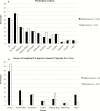E-cigarette Use Among High School and Middle School Adolescents in Connecticut
- PMID: 25385873
- PMCID: PMC4674435
- DOI: 10.1093/ntr/ntu243
E-cigarette Use Among High School and Middle School Adolescents in Connecticut
Abstract
Introduction: There is limited evidence on electronic cigarette (e-cigarette) use among U.S. adolescents.
Methods: Cross-sectional, anonymous surveys conducted in 4 high schools (HS; n = 3,614) and 2 middle schools (MS; n = 1,166) in Connecticut in November 2013 examined e-cigarette awareness, use patterns, susceptibility to future use, preferences, product components used (battery type, nicotine content, flavors), and sources of marketing and access.
Results: High rates of awareness (MS: 84.3%; HS: 92.0%) and of lifetime (3.5% MS, 25.2 % HS) and current (1.5% MS, 12% HS) use of e-cigarettes was observed. Among those who had not tried e-cigarettes, 26.4% of MS and 31.7% of HS students reported being susceptible to future use. Males (OR = 1.70, p < .01), older students (OR = 1.39, p < .05), Caucasians (OR = 2.01, p < .001), ever cigarette smokers (OR = 13.04, p < .001), and current cigarette smokers (OR = 65.11, p < .001) were more likely to be lifetime e-cigarette users and to report greater future susceptibility (males: OR = 1.30; Caucasians: OR = 1.14; ever cigarette smokers; OR = 3.85; current cigarette smokers; OR = 9.81; ps < .01-.001). Among MS students who were lifetime e-cigarette users, 51.2% reported that e-cigarette was the first tobacco product they had tried. E-cigarettes that were rechargeable and had sweet flavors were most popular. Smokers preferred e-cigarettes to cigarettes. Current cigarette smokers were more likely to initiate with nicotine-containing e-cigarettes, and ever and never cigarette smokers to initiate with e-cigarettes without nicotine. Primary sources for e-cigarette advertisements were televisions and gas stations and, for acquiring e-cigarettes, were peers.
Conclusions: Longitudinal monitoring of e-cigarette use among adolescents and establishment of policies to limit access are imperatively needed.
© The Author 2014. Published by Oxford University Press on behalf of the Society for Research on Nicotine and Tobacco. All rights reserved. For permissions, please e-mail: journals.permissions@oup.com.
Figures
References
-
- Regan AK, Promoff G, Dube SR, Arrazola R. Electronic nicotine delivery systems: adult use and awareness of the ‘e-cigarette’ in the USA. Tob Control. 2013;22:19–23. - PubMed
-
- Etter JF, Bullen C. Electronic cigarette: users profile, utilization, satisfaction and perceived efficacy. Addiction. 2011;106:2017–2028. - PubMed
-
- U.S. Department of Health and Human Services. Preventing tobacco use among youth and young adults: a report of the surgeon general. Atlanta, GA: U.S. Department of Health and Human Services, Centers for Disease Control and Prevention, Office on Smoking and Health; 2012. - PubMed
Publication types
MeSH terms
Substances
Grants and funding
LinkOut - more resources
Full Text Sources
Other Literature Sources
Medical


